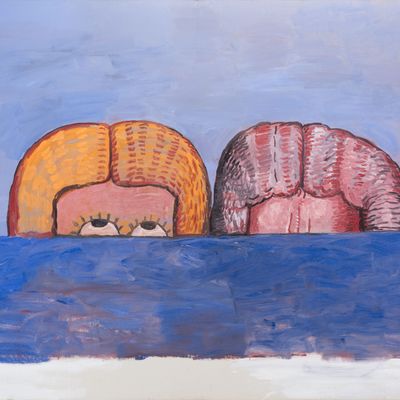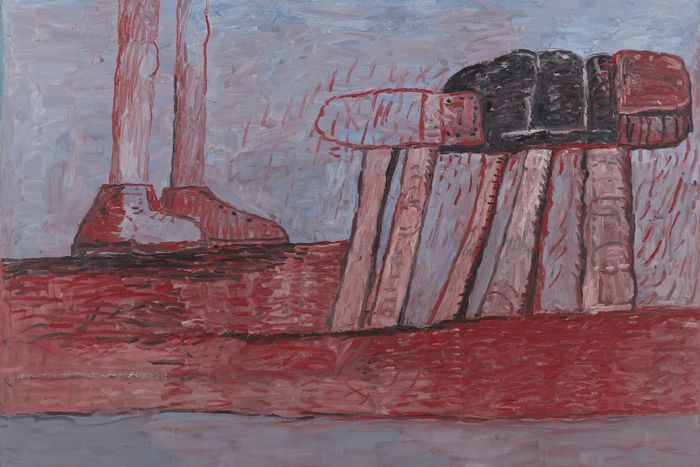
“What Endures,” an exhibition of 13 works by New York School painter Philip Guston, has just opened online at Hauser & Wirth. These paintings were made in a narrow patch of time from 1971 to 1976, the years after Guston shifted from abstraction to figuration with a show at Marlborough Gallery in 1970. The change was not well received: Robert Hughes titled his review “Ku Klux Komix” (though he later came around). In the meantime, many of the same problems that were in the air back then still plague the U.S. and the world today — a corrupt president, protests in the streets, racial injustice, and severe economic insecurity.
Guston made a series of Nixon drawings as well as paintings with hooded Klan figures. But the works in “What Endures,” depicting Roman relics and Guston and his wife, Musa, seem to take a step back from the moment and feel quieter and more intimate. The pieces were curated by Musa Mayer, Guston’s daughter and the president of the Guston Foundation (which just launched a website featuring all the artist’s work). We talked to Mayer about the paintings in the show and how they might help us understand Guston’s thinking during a moment with striking parallels to our own.
In the exhibition text for “What Endures,” you wrote that you were thinking about the “coinciding crises in America now” and how your father’s work spoke to this moment. What is it about the pieces in the show that you felt spoke to this moment?
I always knew that my father was dealing in his work with the pain that he felt so acutely — of the world. That was evident in his very earliest works when he was portraying the horrible cruelty of the Ku Klux Klan, who were marching by the thousands still in the streets of Los Angeles; he witnessed it as a young man. That sense of social injustice and suffering never really left him, and it was always present in his work. I guess it emerged most strongly in the works that were shown at Marlborough Gallery in 1970 that were so controversial, where, after a long sojourn as an abstract painter, he returned to figuration with these really complicated and thoughtful works that were denounced as being crude and cartoonish at the time. Those works will be very much a focus in the upcoming retrospective at the Tate Modern, and I’ve focused in earlier shows on the Nixon drawings and on the works my father did in the years right after the hooded Ku Klux Klan figures. But for this exhibition, it’s sort of a step beyond. It asks, “How did he cope? How did the things that tormented him both in his personal life and the world outside find expression in his work? How was he able to transform them? What were his sources of renewal in the process?”
When Hauser & Wirth asked me to curate an online show, though, I was thinking about how it must have been for my father to be working in isolation — registering all that was going on in the world not only in the ’60s but in the ’70s, when the war in Vietnam was still raging, when Nixon was in office, Watergate. All the turmoil, the assassinations that had happened not long before. I thought he was working with the burden of that societal pain. He was famously quoted in response to a New York Post reporter who had been talking about the change in his work. My father said, “What kind of a man am I, sitting at home, reading magazines, going into a frustrated fury about everything — and then going home to adjust a red to a blue?” That was sort of a key moment, not so much of his wanting to reject abstract painting, because I think what he learned from his own process as an abstract painter was so crucial to what came next, but to delve that deeply into the process of his working.
How do you see those questions playing out in these works and in the three virtual viewing rooms — “The Solace of the Past,” “The Rising Tide,” and “Deliverance” — that you curated for the show?
The first room of the show really focuses on my father’s Italian sojourn and the renewal he found in the past. I called that room “The Solace of the Past.” My father adored Masaccio, and the Brancacci Chapel is one of the great works of all time. I was just talking last night with [artist] Phong Bui, actually, and he was telling me that a month after Masaccio completed the Brancacci Chapel, he died of the plague. In history, it seems that horror side by side with great art is a theme. So much of the art my father adored of the Renaissance documents horror, loss, and pain. That sense of tragedy in the grand aesthetic sense seems to me to be very much a part of my father’s late work. I wanted to show some of those pieces here because we’re in another time like that. There has got to be — I know, for me, there is — in many of us a hunger to find meaning in tragic circumstances, finding what matters to fight the loss. It’s happening to us on a very personal level in terms of our own mortality and coping with that, and you see that in the work.
There’s also an element of risk. When he started making those paintings in 1970 with a totally different look, it was a risk that led to critical rejection, even if those paintings are now considered the iconic works of his life. Do you feel that was a transformative moment for him?
For him, it was never a choice. He could not ever rest, really, with what had already been accomplished. It’s the nature of the art world, of course, to praise artists for the work that’s been completed and to want them to do more of the same. This is what happened to him repeatedly — it happened to him as a figurative painter in the ’40s; people didn’t understand why he turned to abstraction. It happened again when he returned to figuration. He was never more in distress than when he was highly acclaimed. It’s like success always made him uncomfortable.
Why do you think that was?
I think it’s because there was something seductive about it. You know, he always felt the pull to repeat himself, because that’s what the world wanted — some more of those beautiful abstract paintings. But for him, a constant state of self-questioning and doubt and change was completely inherent to his way of working. Nothing else seemed possible, because he couldn’t be authentic in his work unless he was engaged in that process. His doing a series of works that resembled one another was a part of that process too, because he was exploring the dimensions of something he had opened up. But inevitably, he would finish that and move on to something different. People would say, “But those were so beautiful. Why didn’t you continue in that direction?” Many of his peers did continue, the artists of the New York School. My father was always seen as an outlier — someone who really belonged, but he was never about belonging.
In your memoir about your father, Night Studio, you cite something Willem de Kooning said about the 1970s paintings being “about freedom.” What are your thoughts on that?
I have a wonderful quote somewhere; it’s one of those quotes that’s so apt it’s perhaps a little suspicious. So this is a quote from Sartre: “Freedom is what you do with what’s been done to you.” Which is the fundamental existential statement, isn’t it? Or, “shit happens” and then you figure out how you respond to it.
The paintings in the online exhibition feel particularly intimate, especially the ones of your parents. I was wondering about the decision to include those paintings rather than ones that might speak to our present moment in a more explicitly political way, like the Nixon drawings or the paintings of Klan figures.
I think that came from my own response to the works. It was their intimacy, their sense of being isolated — but with somebody you love dearly, which I am fortunate enough to be with my husband. It was that connection to my parents’ marriage and the strength my father drew from that and the support my mother gave him in the midst of a world that seems to be falling apart. Maybe I’m working my way through — I started with the Nixon drawings and then I went to the Roma paintings, so I was very immersed in 1971 when I curated this show. I guess I’m working my way forward through the ’70s.
There’s only one painting in the last room of the exhibition: Both. It feels like a very tranquil, calm-after-the-storm moment.
I love that painting. I love the way it celebrates my mother’s youth and beauty — she was so beautiful — and her old age and decline.
You wrote that the paintings in the exhibition speak to the “transformative power of love.” You mentioned feeling fortunate to be isolating with your husband, and I wondered about that, along with this idea of resiliency — what resiliency looks like on a very personal level.
That’s why I called the show “What Endures.” It’s not only what endures in history, although some of it is that. I realize there’s another level of endurance to think about and talk about — that the images of the atrocities of the past and present, it’s also important that they endure. It’s something about the importance of history and memory and remembering. It’s like what makes it possible to endure these things is very personal and sustaining and has everything to do with love and support. But also, being able to look clear-eyed at what is really happening is important.
“Philip Guston What Endures” is now open online at Hauser & Wirth.



